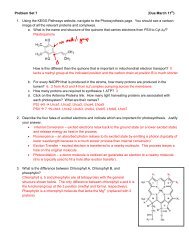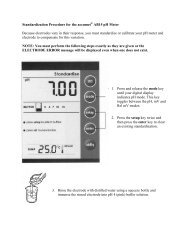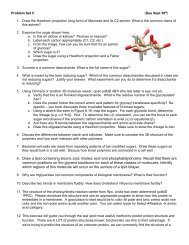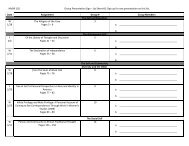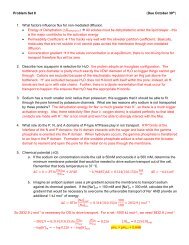Problem Set 6 (Due February 26th) 1. Gluconeogenesis: a. What ...
Problem Set 6 (Due February 26th) 1. Gluconeogenesis: a. What ...
Problem Set 6 (Due February 26th) 1. Gluconeogenesis: a. What ...
Create successful ePaper yourself
Turn your PDF publications into a flip-book with our unique Google optimized e-Paper software.
5. Fructose metabolism is tissue specific.a. Discuss the two pathways for fructose metabolism that feed into glycolysis in the most directway. In most tissues, fructose can be phosphorylated to F6P by hexokinase – this is due to theloose substrate specificity of this enzyme. In the liver, however, hexokinase is expressed invery low levels, so F6P is not readily produced in a one step process. Instead, fructose ismodified at the C1 position to F1P by the action of Fructokinase. This, in turn, is converted toDHAP (glycolysis intermediate) and Glyceraldehyde through the action of a fructose-1-phosphate aldolase, a Type B Aldolase. The latter can be phosphorylated to G3P (glycolysisintermediate) by glyceraldehyde kinase. In the liver, this is the shortest pathway to fructoseentering glycolysis.b. A rapid increase in [fructose] in the liver stimulates triacylglyceride biosynthesis. We will talkabout this much more later in the term, but for now, think about why this may be. Note that F1Pis often produced faster than the Type B Aldolase can cleave it, which leads to a drop in cellularATP and Pi pools. The key to thinking about this problem is noting that ATP is not going to bevery available, meaning that the activity of glyceraldehyde kinase will be dramatically decreaseddue to the lack of substrate availability. So, to maintain the homeostatic concentration ofglyceraldehyde, flux through another pathway must increase. As we discussed in class, analternate fate of glyceraldehyde is to be reduced to glycerol by alcohol dehydrogenase – thisstep does not require ATP, so it will be thermodynamically and kinetically favored (especiallyconsidering that flux through glycolysis is sure to be significantly upregulated due to the very low[ATP] and rapid regeneration of the NAD+ pool is necessary to keep glycolysis movingefficiently). A sharp increase in glycerol ultimately signals hepatocytes to start makingtriacylglycerides – we’ll cover this is a few weeks.
6. Comment on how hexokinase specificity plays a role in mannose, fructose, galactose, and glucosemetabolism. For mannose and galactose, show how a glycolytic intermediate is made. Hexokinasehas a loose specificity profile that allows for many glucose epimers and ketohexoses to be substrates.Of the sugars we discussed, mannose, fructose, and glucose can all be substrates; however galactoseis not tolerated by the active site. This should give you some insight into the way that substratesinteract with the active site. Since galactose cannot be directly phosphorylated, it undergoes a differentset of reactions to generate a glycolytic intermediate.7. PFK is similar to hemoglobin in many ways.a. Discuss the similarities and why this is important. PFK is a tetrameric protein that is subject toallosteric regulation. Both proteins have two common structural forms, the R and T states,which promote or prevent O 2 binding or substrate turnover.b. List all allosteric regulators and comment on their role – does it make sense that it is anactivator or inhibitor? Inhibitors: ATP (signals sufficient energy levels), citrate (signalsabundance of TCA intermediates), PEP (signals elevated glycolytic intermediate levels). All ofthese are products of glycolysis or subsequent pathways and all suggest that glycolysis shouldslow down. Activators: ADP, AMP signal low cellular energy levels. cAMP ad F2,6P keyregulatory molecules that are products of extracellular signals. F6P buildup of substrate.c. How does ATP inhibit PFK? ATP binding in the allosteric site on an adjacent protomer results inthe flipping of an arginine residue out of the active site. This Arg is important in substratebinding because it forms a very stable salt bridge with the phosphate on C6 of F6P. With therotated
8. How are flux through glycolysis and gluconeogenesis controlled in a coordinated manner? This occursthrough a key regulatory molecule (F26P) and protein (PFK-2/FBPase2). F2,6P is the product of anisoform of PFK (called PFK-2) that generates a structural isomer of FBP. F26P is an allosteric activatorof PFK – when it’s around, flux through glycolysis is increased. F26P is a potent inhibitor of FBPase,so it’s presence prevents flux through glycolysis. Activation of PKA through a signal transductionpathway, in response to low blood glucose, results in phosphorylation of the PFK2/FBPase2 protein.This inhibits the PFK2 activity and activates the FBPase2 domain. F26P is hydrolyzed - PFK is nolonger activated and FBPase is no longer inhibited.Additionally, activation of PKA results in inactivation of Pyruvate kinase (decreased flux throughglycolysis) due to phosphorylation. Increased cAMP levels lead to transcriptional activation of PEPCK(increased flux through gluconeogenesis)9. High blood glycerol levels (a result of fat breakdown…and other things) have been shown to promoteglucagon release from pancreatic cells. <strong>What</strong> result does this have on glucose metabolism inhepatocytes (liver cells)? Glucagon stimulates PKA through a GPCR-Adenylate cyclase signaltransduction pathway. PKA activation aggressively influences the activity of many enzymes in thesugar metabolism pathways. Each is highlighted below (Numbers on the images) with a briefexplanation. All of these lead to production of glucose so that it can be transported into the blood.<strong>1.</strong> PFK2 inhibited, FBP2 activated. Flux through glycolysis decreased, gluconeogeneisis increases2. Pyruvate Kinase inactivated – Glycolysis decreased3. cAMP triggered upregulation of PEPCK – gluconeogenesis increased4. PP1 inhibitor phosphorylated – PP1 inhibited. Glycogen breakdown increased.5. Glycogen Synthase phosphorylated – Glycogen synthesis decreased6. Phosphorylase Kinase activated – Glycogen Phorphorylase activated – Glycogen breakdownincreased7. G M phosphorylated @ 2 nd site – PP1 inactivated – Glycogen breakdown increased10. Insulin plays a major role in sugar metabolism in hepatocytes. Based on our discussions in class,describe all the ways it can influence flux through these pathways. Insulin leads to activation of PKBthrough the phosphoinositide pathway. Like PKA, PKB activity has a significant impact on sugarmetabolism. All of these lead to storage of glucose. Intracellular energy demand would have asignificant impact on flux through glycolysis and gluconeogenesis.8. Glycogen Synthase Kinase inactivated – Glycogen synthesis activated.9. G M phosphorylated @ 1 st site – PP1 activated, glycogen Phosphorylase inactivated, GlycogenSynthase activated. Glycogen synthesis increased, glycogen breakdown decreased.10. FoxO1 inactivated. Decreased transcription of PEPCK and G6Pase – both are gluconeogenesisenzymes, so flux through gluconeogenesis is decreased
1<strong>1.</strong> G M is an important adaptor protein that can exist in two different phosphorylation states (as well asunmodified). Describe the metabolic result of each phosphorylation event. In addition, comment on theextracellular conditions that would trigger each phosphorylation event.The first phosphorylation of GM leads to localization of PP1 to a glycogen granule. PP1phosphorylated glycogen synthase, which is an activating modification, and glycogenphosphorylase, an inhibitory modification. So glycogen synthesis is stimulate and glycogendegradation is prevented. This suggests that conditions are sufficient for packing glucose into astorage form, so this must represent a situation where the blood-glucose levels are too high.Indeed, the first phosphorylation event is catalyzed by PKB, which is activated in response toinsulin.The 2 nd phosphorylation event causes PP1 do dissociate form the glycogen granule. It is nolonger able to modify glycogen phosphorylase or synthase, the extracellular conditions mustrepresentative of a glucose-depleted blood. This modification is catalyzed by PKA, which isactivated by glucagon, so the result matches the demand.12. We did not talk about the role AMPK has on global regulation of metabolism throughout all tissues.Please read the attached review and summarize the role this protein plays. There are a large number oftopics you could have selected to focus on here – but the most important point to pick out is that AMPKinase is activated by AMP, so as the [AMP] increases, the activity of AMK increases. This increase in[AMP] can be triggered by depletion of the nutrient supply or by vigorous muscle activity. Whenactivate, AMPK suppresses energy requiring processes and activates energy producing pathways (e.g.glycogen breakdown and glycolysis).



